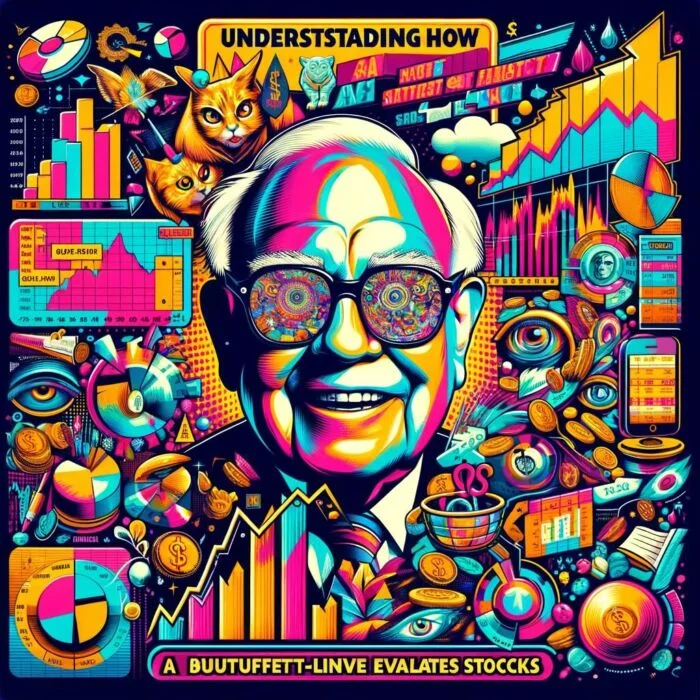If the world of investing were an opera, Warren Buffett would undoubtedly be its maestro, the virtuoso who has conducted the melodies of the market with remarkable finesse for over six decades. Born in Omaha, Nebraska, in 1930, Buffett exhibited a knack for numbers and business at an early age. His journey from running a small pinball machine business as a teenager to becoming the chairman and CEO of Berkshire Hathaway, one of the largest corporations in the world, is nothing short of inspiring.
Known affectionately as the “Oracle of Omaha,” Buffett’s life is a masterclass in investing. His guiding principles of value investing—buying securities that appear underpriced by some form of fundamental analysis—have stood the test of time and market cycles. With a net worth of over $100 billion, he stands as a testament to the power of patient, thoughtful investing. But what truly sets Buffett apart is not just the size of his fortune, but the wisdom he has imparted along the way, his commitment to philanthropy, and his endearing humility.

Importance of Understanding How Buffett Evaluates Stocks
As we embark on our journey to unravel the secrets of Buffett’s investing prowess, one might wonder, “Why is understanding Warren Buffett’s stock evaluation method important?
First, his approach provides a compass in the often tumultuous sea of investing, offering guiding principles that can help investors navigate their decisions. By learning from his methodology, investors can develop a solid foundation for their own investment strategies.
Second, Buffett’s approach emphasizes the importance of self-restraint, patience, and thorough analysis, virtues that are often overshadowed in today’s fast-paced, short-term-oriented investment landscape. Understanding his methods serves as a reminder that investing is as much about character and discipline as it is about numbers.

Lastly, and perhaps most importantly, Buffett’s methods teach us to view investing not just as a means of making money, but as a way of becoming part-owners in businesses. It’s about belief in the value a business offers and its potential for long-term success. This perspective not only enriches our understanding of investing but also enhances the way we view businesses and the world at large.
So, dear reader, fasten your seatbelts as we venture into the fascinating world of Warren Buffett’s investing philosophy. Be prepared to peer into the looking glass of one of the greatest investment minds of our era, and emerge enlightened, equipped, and perhaps even a little inspired.

Warren Buffett’s Investment Philosophy: Value investing approach

Imagine yourself in a bustling marketplace, where a thousand traders are peddling their wares. Amidst the chaos, you find an item that is priced much less than its actual worth. You have recognized a value that others have missed. This, in a nutshell, is the essence of value investing, the school of thought that Warren Buffett has championed throughout his investment career.
In the investment world, the bustling marketplace is the stock market, and the traders are the thousands of publicly traded companies. Buffett’s genius lies in identifying those companies that are undervalued, the hidden gems that the market has overlooked or misunderstood. His approach is not to follow the hot trends, but to meticulously analyze a company’s fundamentals, understand its business model, and estimate its intrinsic value.
Value investing may sound simple, but it requires a keen understanding of business, an eye for detail, and a profound patience to wait for the market to recognize the value you’ve spotted. It’s like playing a game of chess, where you need to think several moves ahead, anticipate the market’s reactions, and have the patience to wait for your strategy to unfold.
The Importance of a Long-term Investment Perspective
Buffett once quipped, “Our favorite holding period is forever.” This statement underscores another fundamental principle of his investment philosophy: the importance of a long-term investment perspective. For Buffett, investing is not about making quick bucks; it’s about owning a piece of a business and reaping the benefits as it grows over time.
This long-term perspective allows Buffett to ignore the short-term noise of the market, the daily fluctuations in stock prices that often lead investors to make hasty and irrational decisions. Instead, he focuses on the company’s long-term prospects, its ability to generate consistent profits over the years, and its resilience to withstand the challenges that lie ahead.
This viewpoint transforms the way we look at stocks: not as ticker symbols on a screen, but as representations of real businesses with products, employees, and a purpose. It also encourages patience and discipline, attributes that are indispensable in the world of investing.
source: The Financial Review on YouTube
Understanding the Concept of ‘Margin of Safety’
Navigating through the storms of uncertainty is a quintessential part of investing. Here, Buffett borrows a concept from his mentor, Benjamin Graham, the father of value investing: the concept of ‘margin of safety.
Imagine you’re about to cross a bridge with a truck loaded with goods. The bridge is rated to hold 10 tons, and your truck weighs 6 tons. That extra 4 tons is your margin of safety. Similarly, in investing, the margin of safety is the difference between the price you pay for a stock and its estimated intrinsic value. By buying stocks for less than their intrinsic value, you create a safety cushion. If your estimations go awry or unexpected events occur, this cushion can help protect your investment from significant loss.

For Buffett, the margin of safety is not an optional accessory, but an essential safety gear for the investment journey. It encapsulates the essence of risk management in investing, the wisdom of not overpaying, and the courage to wait for the right opportunity.
In the grand opera of investing, Buffett’s value investing approach, his long-term perspective, and his emphasis on margin of safety together create a harmonious symphony. It’s a symphony that emanates the wisdom of understanding the true worth of businesses, the patience to let companies bear fruit, and the prudence to guard against uncertainty. As we delve further into his methods, let’s carry these melodies with us, and learn to listen for them in our own investing journeys.
source: New Money on YouTube

Key Metrics Warren Buffett Considers
Earnings Growth
Explanation of Earnings Growth and Why It’s Important
Picture a seedling sprouting from the earth, reaching skyward, yearning for sunlight. Over time, the seedling grows into a towering tree, its branches stretching out, bearing succulent fruit. This process of growth, from a tiny seed to a fruitful tree, mirrors earnings growth in a company – the increase in a company’s net income over time.
Earnings growth is a testament to a company’s ability to expand, innovate, and improve profitability over time. It’s a strong indicator of the company’s health and future prospects. A company with consistent earnings growth is like that towering tree, demonstrating the potential to bear more fruit (profits) in the future.
How Buffett Looks at a Company’s Historical Earnings Growth
Buffett is a keen gardener in the orchard of investments, carefully inspecting the ‘trees’ (companies) for their fruit-bearing capacity. He dives deep into a company’s financial statements, observing the trend in its net income over a considerable period – often ten years or more. He’s not swayed by a single year’s earnings spike driven by short-term factors; instead, he’s interested in sustained growth over the long term, a signal of a fundamentally strong business.
source: Learn With Stanley on YouTube

Return on Equity (ROE)
Definition of ROE and Its Significance
Return on Equity, or ROE, is like a report card for a company’s management. It measures how effectively the management is using the company’s net assets to generate profits. Specifically, ROE is calculated as Net Income divided by Shareholders’ Equity. A higher ROE indicates a more efficient company that’s adept at spinning assets into profits.
Buffett’s Emphasis on Consistent and High ROE
Buffett scrutinizes ROE figures with the precision of a jeweler inspecting a diamond. He favors companies that consistently demonstrate high ROE over time. For him, a high ROE is not just a number; it’s a testament to a company’s competitive advantage and management’s effectiveness. It’s a sign that the company is capable of taking investors’ money and generating solid profits from it.

Debt-to-Equity Ratio
The Meaning of Debt-to-Equity Ratio
The debt-to-equity ratio is a measure of a company’s financial leverage. It shows the proportion of a company’s funding that comes from debt compared to equity. Specifically, it’s calculated by dividing Total Liabilities by Shareholders’ Equity. A higher ratio means more debt, which could signify greater risk if the company faces financial difficulties.
How Buffett Uses This Ratio to Assess a Company’s Financial Health
To Buffett, the debt-to-equity ratio serves as a financial stethoscope, allowing him to gauge the health of a company’s balance sheet. He prefers companies with lower ratios, which suggests they aren’t overly reliant on debt. In his view, a company with less debt is like a sturdy ship, better equipped to weather financial storms.
Price-to-Earnings Ratio (P/E Ratio)
Explanation of the P/E Ratio and Its Importance
The Price-to-Earnings, or P/E ratio, is a way of assessing whether a company’s stock price is high or low relative to its earnings. It’s calculated by dividing the Market Price Per Share by the Earnings Per Share (EPS). The P/E ratio is like a price tag that the stock market puts on a company’s earnings.
Warren Buffett’s Approach to Evaluating a Company’s P/E Ratio
As a value investor, Buffett is always hunting for bargains, and the P/E ratio is one of his go-to tools. He compares a company’s P/E ratio with its competitors, the industry average, and the company’s own historical P/E ratios to ascertain if the stock is underpriced or overpriced.
Remember, for Buffett, investing is about finding diamonds in the rough—companies whose intrinsic value is not fully reflected in their current stock prices. Thus, a lower P/E ratio might signify an undervalued company—an opportunity to buy a dollar for fifty cents. However, he does not base his decisions on the P/E ratio alone. He insists on understanding the reasons behind the numbers. Is the P/E low because the market has overlooked the company, or because the company has serious issues? His decision comes from a blend of quantitative metrics and qualitative analysis.
In the grand tapestry of investing, the metrics of earnings growth, ROE, debt-to-equity ratio, and P/E ratio form crucial threads. They allow investors to weave together a comprehensive picture of a company’s financial health, performance, and valuation. Yet, as we delve deeper into Buffett’s investment philosophy, remember that these numbers are not ends in themselves. They are clues, guiding us towards a deeper understanding of the businesses behind the numbers, their strengths, their potential, and their worth. Let us continue our journey, cherishing the wisdom of Buffett’s words, “Investing is not a game where the guy with the 160 IQ beats the guy with 130 IQ. What’s needed is a sound intellectual framework for making decisions and the ability to keep emotions from corroding that framework.”

Beyond the Numbers: Qualitative Factors Warren Buffett Considers
Quality of Management
The Importance of Effective Leadership in a Company
Picture a ship sailing on the high seas. The strength and durability of the ship are crucial, no doubt, but equally important is the competency of the captain steering the ship. Likewise, in a company, effective leadership plays a critical role in navigating the business through calm waters and stormy seas alike. Great leaders inspire teams, drive innovation, uphold ethical standards, and guide the company towards its long-term goals.
Buffett’s Criteria for Evaluating Management Quality
Buffett is not just an investor; he’s an insightful observer of people. When evaluating a company, he pays close attention to the quality of its management. He looks for leaders with integrity, intelligence, and a passion for their business – leaders who treat the company’s money as scrupulously as their own.
He analyzes their past decisions, their strategic vision, and their communication with shareholders. Are they transparent and honest, even when things go wrong? Do they allocate capital judiciously? Are they focused on long-term success rather than short-term gains? Buffett understands that behind every successful company lies a team of dedicated leaders, and he cherishes such leadership.

Competitive Advantage (Economic Moat)
Explanation of What an Economic Moat is
An economic moat, in simple terms, is a company’s sustainable competitive advantage that protects it from competitors, just as a moat protects a castle from invaders. It could stem from various factors, including brand reputation, cost advantages, proprietary technology, or regulatory barriers.
How Buffett Uses This Concept to Pick Potential Investments
Buffett is a keen castle inspector in the realm of investing, searching for companies with wide and deep economic moats. He believes that such companies are better positioned to maintain their profitability over the long term.
A company like Coca-Cola, for example, enjoys a powerful brand moat. Its iconic brand and global distribution network make it challenging for newcomers to take significant market share. Such companies align perfectly with Buffett’s long-term investment strategy. They offer him the durability and predictability he seeks in his investments.
source: Yahoo Finance on YouTube

Company’s Longevity and Stability
Why the Durability of a Company’s Business Model Matters
In the ever-changing business landscape, the ability to stand the test of time is a commendable feat. Companies with durable business models are often those that can adapt to changes, innovate, and continue to meet their customers’ needs while remaining profitable. These companies are like sequoia trees, standing tall and firm year after year, despite storms and fires.
Buffett’s Preference for Stable and Predictable Businesses
Buffett, being the long-term investor he is, cherishes such sequoia-like companies. He gravitates towards businesses that are stable, those with predictable earnings, and ones that are likely to be around for the next 10, 20, or even 50 years.
This does not mean he avoids all companies in volatile industries; rather, he must understand how they make money and be confident in their long-term prospects. His investment in Apple, a tech company, is a testament to this. Despite the tech industry’s volatility, Apple’s strong brand loyalty, innovative product pipeline, and massive global user base make it a predictably profitable company, making it a quintessential Buffett investment.
As we continue to explore the wisdom of Warren Buffett’s investing philosophy, we see that his genius lies not just in number-crunching. It resides in his ability to see beyond the numbers, to understand the narratives behind them, and to appreciate the human and competitive elements of business. It’s an art as much as it is a science, a blend of analysis and intuition, of mathematics and psychology. Buffett once said, “I am a better investor because I am a businessman, and a better businessman because I am an investor.” This statement underlines the value he places on understanding the businesses behind the stocks.
That understanding allows him to tap into the pulse of the company, feel its rhythm, and gauge its vitality. It’s not just about the current snapshot of numbers; it’s about the past and future story those numbers can tell. The ability to decode this narrative, to comprehend the character of the management, to perceive the width of the competitive moat, and to envision the longevity of the business model – these are what differentiate a good investor from a great one.
Investing, in Buffett’s lens, is not just a financial exercise; it’s a holistic journey of understanding businesses, assessing their worth, and becoming a part-owner in their long-term success. This wisdom from the Oracle of Omaha is the guiding light for investors, illuminating the path that leads to wise and informed investment decisions. We continue our exploration, buoyed by Buffett’s philosophy and ever curious about the vast investment landscape that lies before us.
Case Studies: Applying Warren Buffett’s Evaluation Metrics

Analysis of a Few Investments Buffett Made Using His Key Metrics
Coca-Cola
When Buffett’s Berkshire Hathaway bought a significant stake in Coca-Cola in 1989, it seemed to many a surprising move. The company had faced several challenges in the ’80s, including the New Coke debacle. However, Buffett saw something others didn’t – a company with a wide economic moat and enduring brand value.

Examining the earnings growth, Coca-Cola was on a positive trajectory, and its management was taking steps to correct its previous mistakes. Moreover, the P/E ratio at the time of purchase was relatively low, indicating the market might be undervaluing the company’s potential. Over the years, this investment has paid off handsomely, proving the wisdom of Buffett’s approach.
Apple
Buffett’s investment in Apple in 2016 was a departure from his usual aversion to technology companies. Yet, Apple checked many of the boxes in Buffett’s investment philosophy.
It had robust earnings growth, high ROE, and a relatively reasonable debt-to-equity ratio. Its P/E ratio, while higher than many other companies in Buffett’s portfolio, was lower than many of its technology peers, hinting at potential undervaluation. The company also possessed a formidable economic moat in the form of its strong brand and loyal customer base.
Moreover, Apple’s leadership, under Tim Cook, had demonstrated their capability to sustain the company’s success after the passing of Steve Jobs. Buffett’s significant stake in Apple underscores his principle that understanding the business is more important than sticking to sectors you’re comfortable with.
Lessons Learned from These Investment Decisions
Understanding the Business
Both the Coca-Cola and Apple investments underline the importance of understanding the business. Despite initial doubts from market spectators, Buffett’s deep understanding of these companies’ business models and his faith in their long-term potential led him to make these investments.
The Importance of Patience
These case studies also highlight the value of patience. Buffett didn’t buy these companies expecting to make a quick buck; he bought them with the expectation that their value would increase over the long term. And indeed, they have.

Being Contrarian
Buffett’s moves often go against the grain. When he bought Coca-Cola, many were skeptical. When he invested in Apple, it surprised many given his known tech-aversion. These decisions remind us that following the crowd isn’t the Buffett way; understanding the value and making informed decisions is.
As we dissect these investment decisions, we’re not just studying history; we’re harvesting wisdom. We’re learning that investing isn’t about jumping on the latest trend; it’s about careful analysis, understanding businesses, and making decisions based on conviction, not convention. As we navigate the financial seas, we keep Buffett’s wisdom as our compass, guiding us towards the shores of successful investing.

How Individual Investors Can Apply Buffett’s Methods
Importance of Individual Research and Due Diligence
“Risk comes from not knowing what you’re doing,” Buffett once said, driving home the point that investment is not a game of blind darts; it’s a game of informed decisions. Whether you’re a Wall Street veteran or a new investor venturing into the stock market for the first time, doing your own research and due diligence is crucial.
This means not just following the recommendations of financial pundits or friends, but diving deep into the company’s financials, understanding its business model, studying its management, and having a firm grasp of its industry. It’s like being a detective, collecting clues, piecing them together, and forming an informed conclusion about the company’s value and potential. It’s about taking charge of your investment decisions and being confident in your judgment.

Balancing Quantitative and Qualitative Analysis
As we’ve seen in Buffett’s investment philosophy, both numbers and narratives matter. He’s as comfortable with balance sheets as he is with understanding competitive dynamics. This balance between quantitative and qualitative analysis is something individual investors should strive for.
Quantitative analysis involves looking at financial metrics and ratios, while qualitative analysis includes assessing factors such as the quality of the management team, the company’s competitive advantage, and the sustainability of its business model. Think of it as the marriage of finance and philosophy, number-crunching and storytelling, mathematics and sociology. To be a successful investor, one needs to be adept at this delicate balancing act.
Adapting Buffett’s Principles to One’s Own Investment Strategy
While Buffett’s investment principles provide valuable insights and lessons, it’s essential to adapt them to your own investment goals, risk tolerance, and time horizon. Remember, Buffett’s approach is geared towards long-term value investing. If you’re aiming for short-term gains, this might not be the best approach for you.
Furthermore, while Buffett may avoid certain sectors or types of companies, you may find these align better with your investment strategy. The key is to understand and learn from Buffett’s principles, then adapt them to your unique situation.
Investing, in its purest form, is about buying a piece of a business, not just a stock. It’s about becoming part-owner of a company and sharing in its future success. So, invest in companies you believe in, companies you understand, and companies you’re comfortable owning for a long time. As Buffett advises, “Buy a stock the way you would buy a house. Understand and like it such that you’d be content to own it in the absence of any market.”
As we continue our journey in the world of investing, let us keep these insights in mind. Let’s appreciate the wisdom of Warren Buffett, not just as tips or tricks, but as fundamental principles guiding our investment decisions. As we proceed, remember that investing is not just about making money; it’s about understanding businesses, it’s about patience and diligence, and most importantly, it’s about continuous learning.
source: The Long-Term Investor on YouTube
12-Question FAQ: How Warren Buffett Evaluates Stocks — Key Metrics to Consider
What is Buffett’s starting point when evaluating a stock?
Begin with the business, not the ticker: understand how it makes money, why customers return, and what could break the model. Only if the business is clear and durable does he move to the numbers.
Which profitability metrics matter most to him?
He emphasizes return on equity (ROE) and especially return on invested capital (ROIC)—evidence the firm can compound owner capital above its cost, sustainably and without heroic assumptions.
How does Buffett think about “owner earnings” and free cash flow?
He looks beyond accounting earnings to owner earnings / free cash flow (FCF)—cash after maintenance capex that can be distributed or reinvested at high returns. Stable, growing FCF with modest capital intensity earns high marks.
What role do margins and pricing power play?
Consistent or rising gross/operating margins signal a moat and pricing power. Temporary spikes don’t impress him; multi-year stability in margins through cycles does.
How does he evaluate balance sheet risk?
He prefers low leverage and ample interest coverage. A strong balance sheet protects the moat, enables opportunistic buybacks/M&A, and reduces the chance of forced, value-destructive actions.
Which valuation lenses does he use beyond P/E?
Contextual tools like EV/EBIT, EV/FCF, and owner-earnings yield versus the firm’s reinvestment runway. A fair price for a truly wonderful business beats a “cheap” price for a mediocre one.
How does growth factor into the analysis?
Growth only helps if it’s value-accretive—i.e., incremental ROIC exceeds the cost of capital. He favors predictable, durable growth over rapid but fragile expansion.
What qualitative “moat” traits does he seek?
Enduring brand, network effects, switching costs, cost advantages, or regulatory/structural barriers that defend returns. He wants moats that widen over time, not just withstand today.
How does management quality enter the picture?
He prizes integrity, rationality, and capital-allocation skill: investing in high-ROI projects first, shunning diworsifying M&A, buying back shares only when below intrinsic value, and communicating candidly.
What is “circle of competence” and how does it limit picks?
It’s knowing exactly what you understand—and passing on the rest. If he cannot model the economics a decade out with reasonable confidence, he simply doesn’t play.
How is margin of safety established in practice?
Buy at a meaningful discount to a conservatively estimated intrinsic value (often derived from cash flows). Balance-sheet strength, recurring revenues, and sticky customers increase that safety cushion.
What are practical red flags that disqualify a candidate?
Chronic cash shortfalls vs. reported earnings, rising leverage to fund dividends/buybacks, shrinking margins, moat erosion (share losses, discounting), management empire-building, and valuation that assumes perfection.
Conclusion: How Warren Buffett evaluates stocks
As we reach the culmination of our exploration into the investment philosophy of the Oracle of Omaha, we’ve journeyed through the thought process, principles, and key metrics that Warren Buffett considers when evaluating stocks. We’ve delved into his admiration for consistent earnings growth, his respect for high return on equity, his cautious eye on debt-to-equity ratio, and his careful analysis of the price-to-earnings ratio. We’ve also examined the qualitative factors that he weighs — the quality of management, the width of the company’s economic moat, and the durability of the business model.

Enduring Value of Buffett’s Investment Principles
The sage advice and principles of Warren Buffett stand as a timeless beacon in the ever-changing, often turbulent world of investing. His approach underlines the fact that investing is not just about numbers and balance sheets, but also about understanding the narrative behind a business, its competitive advantage, and its long-term prospects. These principles have not only guided Buffett to become one of the most successful investors in the world, but they have also served, and will continue to serve, as invaluable lessons for investors around the globe.
Encouragement for Individual Investors to Learn from Buffett’s Approach
As individual investors, we are not just participants in the financial markets; we are students of investing. And in Warren Buffett, we have a mentor whose wisdom is backed by a remarkable track record of success.
While we may not have the financial clout of Berkshire Hathaway or access to the same information as Buffett, we can certainly adopt his approach to research, analysis, and patient, long-term investing. We can strive to understand the businesses behind the stocks. We can learn to balance our analysis between numbers and narratives. We can approach investing with the eyes of a business owner, not just a trader.
In the grand theater of investing, we are the actors, and the principles of Warren Buffett can be our script. However, every actor brings their unique interpretation to a script. Similarly, as we learn from Buffett’s principles, we should adapt them to our unique investment goals, risk tolerance, and understanding of the market.
Let us continue our investing journey, armed with the wisdom of Warren Buffett and a passion for learning. Remember, investing is not a sprint; it’s a marathon. It’s not about quick riches; it’s about building wealth over time. And as Warren Buffett reminds us, “Someone’s sitting in the shade today because someone planted a tree a long time ago.” Let’s start planting our trees today.
Important Information
Comprehensive Investment Disclaimer:
All content provided on this website (including but not limited to portfolio ideas, fund analyses, investment strategies, commentary on market conditions, and discussions regarding leverage) is strictly for educational, informational, and illustrative purposes only. The information does not constitute financial, investment, tax, accounting, or legal advice. Opinions, strategies, and ideas presented herein represent personal perspectives, are based on independent research and publicly available information, and do not necessarily reflect the views or official positions of any third-party organizations, institutions, or affiliates.
Investing in financial markets inherently carries substantial risks, including but not limited to market volatility, economic uncertainties, geopolitical developments, and liquidity risks. You must be fully aware that there is always the potential for partial or total loss of your principal investment. Additionally, the use of leverage or leveraged financial products significantly increases risk exposure by amplifying both potential gains and potential losses, and thus is not appropriate or advisable for all investors. Using leverage may result in losing more than your initial invested capital, incurring margin calls, experiencing substantial interest costs, or suffering severe financial distress.
Past performance indicators, including historical data, backtesting results, and hypothetical scenarios, should never be viewed as guarantees or reliable predictions of future performance. Any examples provided are purely hypothetical and intended only for illustration purposes. Performance benchmarks, such as market indexes mentioned on this site, are theoretical and are not directly investable. While diligent efforts are made to provide accurate and current information, “Picture Perfect Portfolios” does not warrant, represent, or guarantee the accuracy, completeness, or timeliness of any information provided. Errors, inaccuracies, or outdated information may exist.
Users of this website are strongly encouraged to independently verify all information, conduct comprehensive research and due diligence, and engage with qualified financial, investment, tax, or legal professionals before making any investment or financial decisions. The responsibility for making informed investment decisions rests entirely with the individual. “Picture Perfect Portfolios” explicitly disclaims all liability for any direct, indirect, incidental, special, consequential, or other losses or damages incurred, financial or otherwise, arising out of reliance upon, or use of, any content or information presented on this website.
By accessing, reading, and utilizing the content on this website, you expressly acknowledge, understand, accept, and agree to abide by these terms and conditions. Please consult the full and detailed disclaimer available elsewhere on this website for further clarification and additional important disclosures. Read the complete disclaimer here.





